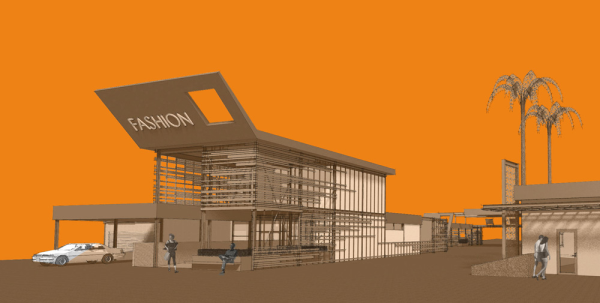Discover the Cutting-edge Solutions Offered by Commercial Architects for Your Following Project
Commercial architects play an important duty fit the built setting. They blend capability with aesthetic appeal, developing areas that resonate with brand name identity. These specialists employ ingenious design remedies, sustainable techniques, and advanced modern technologies to improve customer experiences. Their collective technique guarantees alignment with client visions and operational needs. Nonetheless, the extent of their services usually expands past design. The next action in recognizing how these architects browse intricate project needs might amaze you.
Recognizing the Role of Commercial Architects
The duty of business architects might differ depending on the certain task, their key feature rotates around making practical and visually attractive rooms for companies. These experts are charged with recognizing the one-of-a-kind demands of each customer, whether it be a retailer, office complex, or industrial center. They perform extensive site analyses and work together with stakeholders to guarantee that the design lines up with the organization goals and brand identity.Commercial architects also navigate numerous governing needs, protecting compliance with zoning legislations and building ordinance. Their expertise encompasses creating sustainable designs that advertise energy efficiency and environmental obligation. Furthermore, they manage the task's timeline and budget plan, collaborating with contractors and engineers throughout the building and construction process. By blending imagination with technical expertise, industrial architects play a crucial role in transforming conceptual concepts into substantial facts, ultimately enhancing the functionality and charm of commercial areas.
Cutting-edge Layout Solutions for Special Areas
As commercial rooms progressively require diversity to attract attention in open markets, ingenious style services have actually come to be necessary for architects. These experts leverage their imagination and technological competence to craft one-of-a-kind environments that mirror brand name identification and improve user experience. By incorporating cutting-edge modern technology and products, commercial architects can change ordinary areas into enchanting places that engage consumers and influence employees.Architects use different approaches, such as flexible reuse, which renews existing frameworks while preserving their historical relevance. They likewise explore unusual designs and multifunctional rooms that accommodate diverse demands, making certain versatility for future growth.Furthermore, the incorporation of biophilic style-- bringing nature inside your home-- creates inviting environments that advertise health - commercial architects. This focus to detail in ingenious design not just addresses visual problems however also promotes neighborhood and cooperation. Inevitably, these tailored remedies enable organizations to thrive in an ever-evolving landscape, setting them apart from competitors
Sustainable Design Practices
Lasting architecture practices have actually become a critical focus for business architects seeking to produce impactful styles that resonate with ecological stewardship. These methods prioritize making use of renewable sources, power efficiency, and minimal waste, mirroring a dedication to minimizing the ecological footprint of structures. Architects include materials that are sustainably sourced or reused, guaranteeing that building and construction techniques straighten with environmental principles.Furthermore, the assimilation of eco-friendly roofing systems and wall surfaces boosts biodiversity while boosting power efficiency. Efficient water monitoring systems, such as rain harvesting, add to sustainability by conserving water sources. Natural air flow and daylighting methods are additionally employed to maximize indoor atmospheres, decreasing reliance on artificial heating and illumination.
Integrating Technology in Architectural Designs
An enhancing number of commercial architects are accepting innovation as a transformative component in building style. By leveraging sophisticated software program devices such as Structure Info Modeling (BIM), architects can develop in-depth 3D depictions of projects, permitting improved visualization and collaboration among stakeholders. This innovation helps with real-time modifications, reducing mistakes and enhancing the layout process.Additionally, architects are integrating clever structure innovations right into their styles, which improve energy efficiency and occupant comfort. Functions such as automated illumination, climate control, and safety and security systems can be seamlessly integrated, promoting sustainable methods and minimizing functional costs.The use of virtual and enhanced truth also allows clients to experience designs before building and construction begins, providing invaluable understandings right into spatial relationships and aesthetic choices. Eventually, the combination of modern technology in architectural layouts not only cultivates innovation however also assures that jobs are carried out with precision and lined up with modern demands.

Job Administration and Coordination Providers
Effective project administration and more info here coordination services are essential for the effective implementation of commercial building jobs. These solutions guarantee that all facets of a project, from first style to final building and construction, are flawlessly incorporated. Commercial architects play a significant duty in working with between various stakeholders, including clients, professionals, and vendors, to keep clear interaction and placement on task goals.By executing structured methods, architects can handle timelines, budget plans, and resources properly, reducing hold-ups and expense overruns. They use task management software program and tools to track development, take care of documents, and help with cooperation amongst group members.Additionally, these solutions consist of threat analysis and mitigation strategies, validating possible challenges are recognized and dealt with proactively. The outcome is a structured process that enhances general job performance and high quality, inevitably resulting in a successful outcome that satisfies the client's vision and assumptions.
Governing Conformity and Zoning Assistance
Efficient regulatory compliance and zoning aid are necessary for the success of any type of business task. Architects must possess a deep understanding of local policies and zoning regulations to direct customers through the complexities of the approval procedure. This proficiency not only guarantees adherence to legal needs but likewise helps enhance project design and performance.
Browsing Local Regulations
Exactly how can industrial architects ensure their layouts line up with neighborhood guidelines? By remaining well-informed about the ever-evolving landscape of building ordinance and regional regulations, architects play an important function in guaranteeing compliance. They perform detailed study to recognize the particular guidelines regulating products, safety requirements, and building and construction techniques applicable per task. Working together carefully with regional authorities, business architects can navigate through the intricacies of governing structures efficiently. They additionally promote essential permits and inspections, enhancing the approval process. This positive approach not only reduces potential lawful complications yet likewise improves project performance. Eventually, their expertise in steering regional policies encourages customers to realize their vision while sticking to all needed standards and standards.
Zoning Law Proficiency
Zoning regulation competence is vital for commercial architects guiding through the intricacies of land use guidelines. These architects possess in-depth expertise of regional zoning codes, which govern home growth, land use, and structure specifications. By recognizing these policies, they aid clients navigate the commonly elaborate authorization procedures required for building and construction projects. Their experience guarantees conformity look here with zoning regulations, reducing the threat of job delays or lawful complications.Additionally, business architects offer useful assistance in obtaining essential authorizations and differences, promoting smoother interactions with neighborhood authorities. They additionally supply calculated suggestions to maximize website layout and make best use of the potential of a property while adhering to zoning limitations. Inevitably, their zoning legislation proficiency plays a pivotal function in the effective understanding of industrial projects.
Collective Approaches With Clients and Stakeholders
Successful business style hinges on the ability to foster solid partnership with clients and stakeholders throughout the design process - commercial architects. Architects take part in open dialogues, ensuring that all events' visions and needs are integrated into the job. This collaborative technique starts in the preliminary stages, where architects carry out workshops and brainstorming sessions, allowing customers to verbalize their goals and concerns.Stakeholder input is equally vital; architects typically organize meetings with community participants, city governments, and other pertinent entities to gather diverse viewpoints. By utilizing visualization tools, such as 3D modeling, architects assist in better understanding and communication.This repetitive comments procedure not only boosts layout quality however likewise develops depend on, leading to even more successful end results. Eventually, the joint approach of commercial architects changes ideas right into practical areas that mirror the goals of customers and the wider community, ensuring an unified relationship throughout the job lifecycle
 this contact form alt="commercial architects
this contact form alt="commercial architects"/>
Often Asked Questions
What Is the Normal Timeline for a Business Style Project?
The typical timeline for a commercial design job varies, typically covering 6 to 18 months. Elements influencing this period consist of job complexity, regulatory authorizations, and customer responsiveness, affecting each phase from layout to building and construction completion.
Just How Do Commercial Architects Fee for Their Services?
Commercial architects usually charge based upon task range, complexity, and size. Usual charge structures consist of per hour prices, taken care of charges, or percentage-based costs computed from the overall construction price, making sure transparency and placement with client assumptions.
Can Commercial Architects Assist With Interior Decoration?
Commercial architects can indeed help with interior decoration, integrating capability and aesthetic appeals. Their experience assurances natural areas that align with building vision, improving user experience while fulfilling governing needs and customer objectives with cutting-edge layout solutions.
What Types of Customers Do Commercial Architects Generally Work With?
Commercial architects commonly collaborate with diverse clients, consisting of businesses, government entities, academic institutions, and non-profit organizations (commercial architects). Each client looks for tailored architectural remedies to meet certain functional and visual demands for their tasks and atmospheres
How Do Commercial Architects Keep Upgraded With Design Trends?
Commercial architects stay upgraded with layout fads through continuous education and learning, attending industry seminars, taking part in specialist networks, and researching emerging innovations. They likewise team up with other specialists to acquire insights into cutting-edge materials and layout techniques.